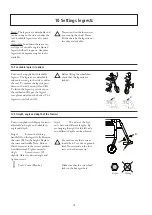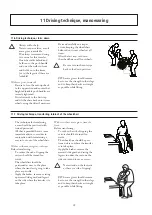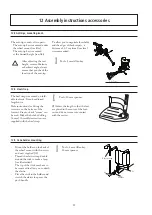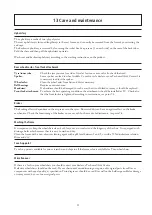
24
13 Care and maintenance
Problem*
Solution
Fault-finding chart
(!) When necessary, lubricate moving parts/joints with bicycle oil or similar.
* The user may experience several of these problems if the wheelchair is incorrectly adjusted or is being incorrectly used.
The wheelchair pulls to the side
The wheelchair feels “heavy” to propel
The wheelchair feels “heavy” to turn
Brakes not effective
Rear wheels “loose”
Rear wheels hard to remove/replace
The castors “wobble”
The wheelchair is hard to fold/unfold
The wheelchair feels “awkward”
- Inflate the tyres
- Adjust the angle of the front fork attachment.
- Check that the front fork attachments are mounted at the same height.
- Rear wheel mountings are incorrectly fitted
- The user is distributing weight unevenly
- More strength being used on one side than the other when propelling
the chair
- Inflate the tyres
- Rear wheel mountings are incorrectly fitted
- Clean the castor axles from hair and dirt
- Too much weight over the castors. Adjust the centre of balance
- Inflate the tyres
- Check that the front fork attachments are not too tight.
- Adjust the angle of the front fork attachment.
- Clean the castor axles from dirt
- Too much weight over the castors. Adjust the centre of balance
- Inflate the tyres
- Adjust the distance between brake and tyre
- Ensure that the axle-shaft washer is in place
- Adjust the length of the axle shaft
- Clean and lubricate quick release
- Adjust the length of the axle shaft
- The front forks are not tight enough
- Check that the front fork attachments are mounted at the same height
- Adjust the front fork attachment’s angular setting
- Too much weight over the castors. Adjust the centre of balance
- The upholstery is too tight
- Clean and lubricate the cross-brace under the seat
- Inflate the tyres
- Check that screws, nuts and bolts are properly tightened





































